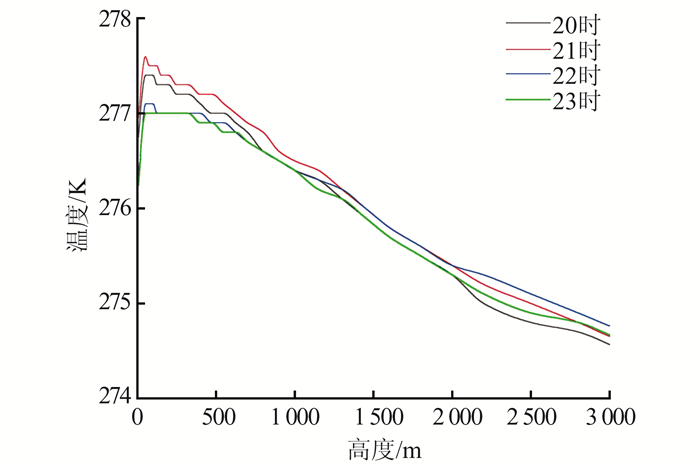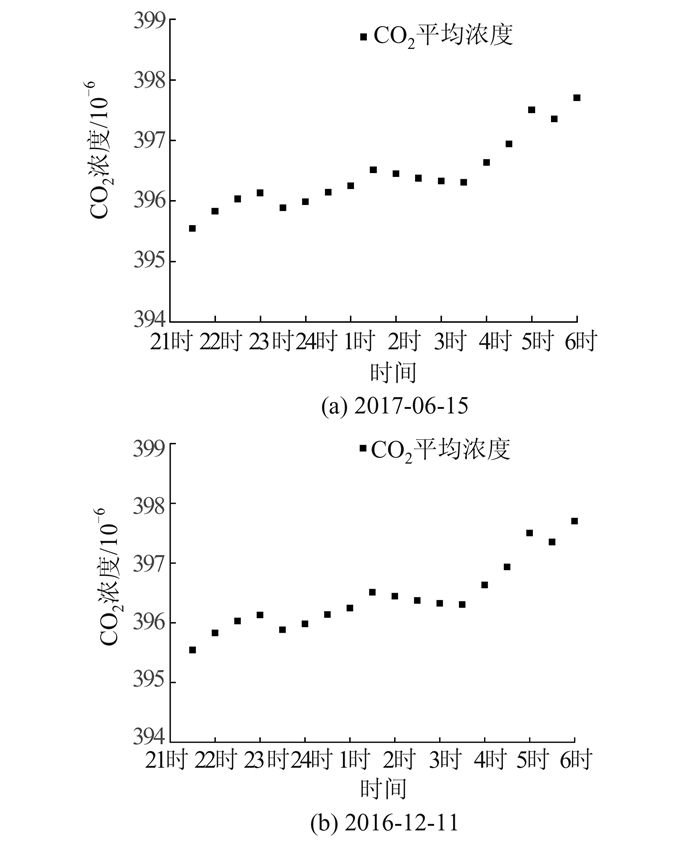-
摘要: 针对大气中二氧化碳(CO2)浓度在对流层分布变化明显的特点,采用激光雷达主动观测方式获取低空CO2廓线浓度。利用自主研制的基于染料差分激光技术的CO2探测差分吸收激光雷达,在中国安徽省淮南市进行了长期观测,受制于白天的低信噪比,只进行了夜间观测,并通过开发先进的信号处理算法获取了高空间、高时间分辨率的CO2廓线浓度以及低空平均浓度,测量结果能够在一定程度上反映江淮平原地区CO2浓度垂直分布的变化规律。得到了冬夏夜间典型的低对流层CO2垂直分布特点:夜间CO2浓度持续增加,且夏季夜间CO2浓度增幅大于冬季,一年中夏季的CO2浓度最低(403.2×10-6),冬季最高(412.7×10-6)。目前该设备已运至西藏羊八井地区(海拔4 300 m)进行持续观测,成功获得了关键的CO2廓线信息,可用于平原和高原CO2垂直分布特征的对比分析,并为研究青藏高原对温室气体的传输效应提供重要的观测资料。Abstract:Objectives Carbon dioxide(CO2) is the main component of greenhouse gases. Facing the urgent need of carbon peak and carbon neutralization, differential absorption light detection and ranging(LiDAR) is an ideal remote sensing method for measuring CO2. In view of the characteristics that the obvious distribution change of atmospheric CO2 in the troposphere, the low-altitude CO2 concentration profile is obtained by differential absorption LiDAR.Methods Using the self-developed CO2 detection differential absorption LiDAR based on dye differential frequency laser technology, long-term observations were carried out in Huainan City, Anhui Province. Subject to low signal-to-noise ratio in the daytime, only nighttime observations were conducted. And through the development of advanced signal processing methods, high-space, high-time resolution CO2 concentration profile and low-level average concentration were obtained.Results The measurement results can representatively reflect the variation of the vertical distribution of CO2 concentration in the plains of the middle and lower reaches of the Yangtze River. The typical CO2 vertical distribution in winter and summer nights in low tropospheric is concluded: The CO2 concentration continues to increase during nighttime. And the increase of CO2 concentration in summer night is greater than that in winter. The lowest CO2 concentration occurred in summer and the highest one occurred in winter.Conclusions Ground based differential absorption LiDAR can obtain the spatial distribution of CO2, which can provide key data in the quantitative study of carbon source and carbon sink. At present, the equipment has been transported to the Yangbajing area of Tibet (4 300 m above sea level) for continuous observation, and the key CO2 profile information has been successfully obtained. It can be used for comparative analysis of the vertical distribution characteristics of CO2 in plains and plateaus, and provides important observational data for studying the transmission effect of the Qinghai-Tibet Plateau on greenhouse gases.
-
变化是地理实体、现象的基本特征之一。有些变化是自然灾害所致,例如地质灾害、沙尘暴、风暴等引起的地表、自然资源和环境的变化;而有些变化则是因为人类活动造成的,例如城市扩张所致的土地覆盖和土地利用的变化。变化检测是通过对地理实体或现象进行多次观测以检测和提取发生在地理实体或现象中变化信息的技术手段,即通过不同时间的观测来识别物体或现象状态差异的过程[1]。卫星遥感以其观测范围大、同一地区周期性重访等特点,可为低代价、高时效的环境监测提供及时、准确、一致的地球表面信息[2],为地表地理现象的变化检测提供技术支撑,因此广泛应用于地表信息的变化检测中。
地理实体或现象的变化信息可为自然资源管理、灾害监测、生态环境保护和可持续发展提供科学依据。光学遥感影像变化检测在众多领域中都有广泛的应用需求。归纳起来,光学遥感变化检测过程可以被看作是一个从多时相遥感数据开始,经过数据预处理、变化检测、精度评价的影像处理链。如图 1所示,其中多时相数据是指对同一地理范围在不同时间进行多次观测所得的光学遥感影像,是变化检测的数据基础。预处理包括多时相遥感影像的几何校正、辐射校正、配准处理等。变化检测是将多时相遥感影像作为输入,利用变化检测算法从影像中检测变化信息的关键过程。精度评估是对变化检测结果的精度进行评价的过程。
1977年,Weismiller等[3]提出影像差分方法,这是最早的变化检测算法,标志着光学遥感影像变化检测研究的开始。40年来,研究人员对变化检测进行了长期的研究,围绕变化检测处理链的各环节,发表了众多研究成果,亦从不同方面对变化检测方法进行了一定的总结[2, 4]。
为了比较全面地回顾几十年来光学卫星遥感变化检测领域的研究进展,总结光学遥感影像变化检测的成果并探讨未来有待解决的问题,本文试图从变化检测方法、面临的挑战和应用领域等多个方面,从不同的角度对光学遥感影像变化检测的进展进行回顾和总结,并展望光学遥感影像变化检测技术的未来研究发展趋势。
1 光学遥感影像变换检测的主要方法分类
由于光学遥感卫星的传感器不同,影像的光谱分辨率、空间分辨率等各不相同。40年来,研究者针对不同的光学遥感影像开发了多种变化检测方法。本文从处理单元、算法、是否需要先验知识3个方面对这些方法进行系统总结,如图 2所示。
1) 变化检测处理单元
像元是光学遥感变化检测的基本处理单元。40年来研究者发表了许多像元级光学遥感影像变化检测方法[5-8]。亚像元因可以构造更加精细分辨率的影像图以弥补空间分辨率的不足,但无法精细反映地表覆盖的问题,因此在亚像元级进行变化检测是近年来研究者关注的方向之一[9-10]。随着光学遥感影像空间分辨率的提高,越来越多的高分辨率影像在各领域得到应用。高分辨率影像一方面承载了更加丰富的地表信息,另一方面,也导致同一地物的光谱特征离散化问题,降低了基于像元变化检测的精度。因此,面向对象的变化检测方法在土地覆盖/利用、灾害监测评估和城市扩张等许多领域得到有效应用[11-14]。
2) 变化检测算法
Menz[15]提出并系统分析了从变化检测到变化建模的发展历程,通过对1970-2013年期间发表在《Remote Sensing of Environment》《Photogrammetric Engineering & Remote Sensing》《International Journal of Remote Sensing》和《IEEE Transactions on Geoscience and Remote Sensing》等期刊中的变化检测文献进行总结,把遥感影像变化检测方法归纳为代数法(algebra)、变换法(transformation)、分类法(classification)和目视解译法(visualisation)。此外,随着智能技术的发展和深入应用,智能深度学习算法逐渐进入遥感影像变化检测领域[16-17]。
3) 先验知识
根据变化检测算法是否需要基于先验知识,光学遥感影像变化检测的方法可分为非监督、监督和基于上下文的变化检测[2]。非监督变化检测算法无需研究区域的先验知识,通常用于产生研究区域的变化和非变化的二值图[18-19]。传统的监督法通常使用分类后比较逻辑进行变化检测。而上下文信息在影像理解和分析中扮演了一个重要的角色,在遥感影像变化检测的影像对比或分类阶段都可以利用空间上下文信息[20-22]。
2 变化检测算法进展
40年来,国内外学者们提出或发展了数以千计的变化检测方法。这些方法在土地利用/覆盖、城市扩张、灾害监测、生态环境保护、湿地变化监测、森林砍伐和荒漠化等众多领域中得到广泛应用。前文已通过对40年来的变化检测方法进行回顾,把光学遥感影像变化检测的方法总结为代数法、变换法、分类法、目视解译法和深度学习法等5种类型。本节拟从方法提出的时间(年代)、数量和应用领域3个维度,进一步分析国内外光学遥感影像变化检测方法的发展。
为了分析国际上光学遥感影像变化检测方法的进展,本文以变化检测和应用领域为检索条件,对1970-2018年期间发表在遥感领域的国际重要期刊《Remote Sensing of Environment》《Photogrammetric Engineering & Remote Sensing》《Remote Sensing》《International Journal of Remote Sensing》《IEEE Transactions on Geoscience and Remote Sensing》和《IEEE Transactions on Geoscience and Remote Sensing Letters》上的研究论文进行了检索。根据检索结果,对不同类型的算法在年代、数量和应用等3个不同的维度上的进展进行了分析,图 3所示为时间+应用所构成的矩阵。
图 3中,横坐标代表光学遥感影像变化检测的应用领域,包括土地利用、城市扩张、农田变化等7大领域及其他应用领域与纯算法,纵坐标代表年份,每10 a为一个年代间隔。从数量上看,光学遥感影像变化检测方法随年代的变化而增加。年代越近,算法越多,年代越久远,算法数量也越少。从应用领域也可以看出,随着光学遥感影像变化检测研究的逐步深入,应用领域也在逐渐扩大,从最初的生态环境保护等少数领域逐渐扩展到土地利用、城市扩张、农田变化、地质灾害监测、生态环境保护、湿地监测、森林防护及其他领域。从方法类型看,随着年代的变化,变化检测方法的类型也在增加,特别是2000年以来,深度学习开始逐步在遥感影像变化检测中应用。可见,国际上光学遥感影像变化检测方法研究的深度、广度及应用领域的广度均随时间的推进而增强。
为研究变化检测在中国的发展趋势,本文以“变化检测”为检索关键词,分别以主题、篇名和关键词为检索项对1970年以来的中文核心期刊和工程索引源刊进行了检索,并对检索结果进行分析,得到以主题为检索项的分析结果构成的应用领域——年代方法发展矩阵(图 4),以及以篇名或关键词为检索项所检索文献分析结果构成的应用领域——年代方法发展矩阵(图 5)。
将图 4和图 5与图 3比较可发现,中国关于光学遥感影像变化检测方法的研究起步较晚,20世纪90年代后才陆续有研究方法发表;国内期刊发表的文献数量无论从年代还是应用领域来看都晚于少于国际同行。但从数量、类型和应用领域的发展趋势上看,国内与国际上的研究基本保持一致。不过,深度学习在变化检测中的应用,在国内尚处在方法探索中,鲜有该主题文献报道。
3 光学遥感影像变化检测面临的挑战
研究人员在光学遥感影像变化检测方法上投入了大量的精力,40年间取得了丰富的成果。然而,光学遥感影像变化检测的挑战依然存在。这是因为,一方面方法仅为变化检测处理链(图 1)中的一个环节,处理链中每个环节对变化检测结果都十分重要;另一方面,变化检测方法也有许多需要进一步完善之处。概括起来,光学影像变化检测在数据源、算法的适用性、结果标记和可靠性等方面仍然存在挑战。
1) 数据的不确定性
多时相遥感影像是光学遥感影像变化检测的数据源。然而,数据源的不确定性仍然是变化检测面临的挑战之一。一方面,观测现象存在不确定性;另一方面,成像传感器也存在诸多问题,如对地面变化的观测能力有限,成像过程中存在固有的噪声,不同传感器影像间不够兼容[2]。观测现象的不确定性和传感器问题将直接导致观测所得多时相遥感数据的不确定性,使变化检测过程变得复杂和不确定,多时相遥感影像变化检测结果的精度也因此难以保证。
2) 算法的普适性不高
传感器和变化检测过程的不确定性以及多时相观测中的物候、土壤湿度、太阳入射角等问题,不仅导致了多时相光学遥感影像的空间分辨率、光谱分辨率、辐射分辨率和时间分辨率差异,还会导致噪声和畸变(包括几何、辐射)。这就要求在设计或选择变化检测方法时仔细考虑影像的变化和现象的特征,很难有单一算法可以处理所有类型的变化检测问题。不同的应用需要不同类型的传感器,不同传感器的数据要求不同的方法,不同的方法在不同的数据中需要不同的参数。以上种种使得变化检测方法的适应性或普适性普遍不高。
3) 变化结果的科学标记问题
传统上,变化检测更多的是一种二值检测,即利用多时相遥感影像借助变化检测方法产生变化和未变化两种类型的二值图。阈值选择问题是这一过程中一个极具挑战性的问题。同时,随着变化检测应用的深入,很多应用不仅需要检测变和未变的问题,更重要的是要知道变成了什么,即研究变化过程或变化轨迹问题[15],这也为变化检测的研究提出了新的要求。
4) 变化检测的可靠性
传感器的不确定性导致数据源的不确定性。同时,变化检测过程,例如多时相遥感影像的几何配准(包括像元级和对象级)、辐射匹配也存在不确定性。这些不确定性为变化检测结果的可靠性带来了挑战。为了抑制数据源和变化检测过程的不确定性,提高变化检测算法和结果的可靠性,近年来,我们针对多方法融合[23]和利用上下文构建空间谱[24]的方法展开了研究。但可靠性变化检测中仍然存在不确定性有效抑制、方法适应性和可靠性量化评估等诸多挑战。
4 总结与展望
光学遥感影像变化检测的理论、方法和技术无疑是光学遥感影像信息处理与分析的基础研究之一。自20世纪70年代开始,研究人员在光学遥感影像变化检测技术方面做了大量的研究工作。特别是在变化检测方法方面,研究人员针对不同传感器、空间分辨率,光谱分辨率、时间分辨率和地表覆盖类型的影像,从亚像元、像元和对象3个处理层次开发了若干监督、非监督及上下文信息辅助的变化检测方法。后来的研究人员则在继承前人研究的基础上对一些方法不断改进和扩展,使得变化检测方法得到了蓬勃的发展。但在应对数据源的不确定性、算法普适性、结果的科学标记和可靠性变化检测等关键问题上仍然存在挑战,光学遥感影像变化检测的一些方法有待进一步发展。
光学遥感影像变化检测有待研究的新方向包括以下方面:①深度学习:通过深度学习方法的引入,提高变化检测方法的智能化、自动化程度与精度。②可靠性:随着变化检测应用的深入,精度不再是人们的唯一关注,变化检测方法和结果的可靠性是重要发展方向。③融合:数据来源的增加,数据源和变化检测过程的不确定性等,使单一方法难以解决各种类型的变化检测,数据融合和方法的融合,是变化检测的新的趋势。
-
表 1 CO2-DIAL激光雷达系统参数
Table 1 Parameters for CO2-DIAL
参数 数值 on-line波长/cm-1 6 359.962 off-line波长/cm-1 6 359.350 线宽/MHz 50 波长稳定性/MHz 10 脉冲能量/mJ 75 脉冲重复频率/Hz 20 脉宽/ns 15 激光发散角/mrad 0.1 望远镜口径/m 1 探测器量子效率/% 3 采集频率/MHz 20 -
[1] Ballantyne A P, Alden C B, Miller J B, et al. Increase in Observed Net Carbon Dioxide Uptake by Land and Oceans During the Past 50 Years[J]. Nature, 2012, 488(7409): 70-72 doi: 10.1038/nature11299
[2] Wunch D, Wennberg P O, Toon G C, et al. A Method for Evaluating Bias in Global Measurements of CO2 Total Columns from Space[J]. Atmospheric Chemistry and Physics, 2011, 11(23): 12317-12337
[3] Boesch H, Baker D, Connor B, et al. Global Characterization of CO2 Column Retrievals from Shortwave-Infrared Satellite Observations of the Orbiting Carbon Observatory-2 Mission[J]. Remote Sensing, 2011, 3(2): 270-304 doi: 10.3390/rs3020270
[4] Wunch D, Wennberg P O, Osterman G, et al. Comparisons of the Orbiting Carbon Observatory-2 (OCO-2) X-CO2 Measurements with TCCON[J]. Atmospheric Measurement Techniques, 2017, 10: 2209-2238 doi: 10.5194/amt-10-2209-2017
[5] Wunch D, Toon G C, Blavier J F L, et al. The Total Carbon Column Observing Network[J]. Philosophical Transactions of the Royal Society A: Mathematical, Physical and Engineering Sciences, 2011, 369 (1943): 2087-2112 doi: 10.1098/rsta.2010.0240
[6] 赵文豪, 闫利, 王成义, 等. 基于三维大气探测激光雷达的大气颗粒物污染探测[J]. 武汉大学学报·信息科学版, 2019, 44(10): 1436-1441 doi: 10.13203/j.whugis20190105 Zhao Wenhao, Yan Li, Wang Chengyi, et al. Detection of Atmospheric Particulate Matter Pollution Based on Three-Dimensional Atmospheric Detection LiDAR[J]. Geomatics and Information Science of Wuhan University, 2019, 44(10): 1436-1441 doi: 10.13203/j.whugis20190105
[7] Dong Y N, Du B, Zhang L P, et al. Hyperspectral Target Detection via Adaptive Information: Theoretic Metric Learning with Local Constraints[J]. Remote Sensing, 2018, 10(9): 1415 doi: 10.3390/rs10091415
[8] Ramanathan A K, Mao J P, Abshire J B, et al. Remote Sensing Measurements of the CO2 Mixing Ratio in the Planetary Boundary Layer Using Cloud Slicing with Airborne LiDAR[J]. Geophysical Research Letters, 2015, 42(6): 2055-2062 doi: 10.1002/2014GL062749
[9] Han G, Cui X H, Liang A L, et al. A CO2 Profile Retrieving Method Based on Chebyshev Fitting for Ground-Based DIAL[J]. IEEE Transactions on Geoscience and Remote Sensing, 2017, 55(11): 6099-6110 doi: 10.1109/TGRS.2017.2720618
[10] Du J, Zhu Y D, Li S G, et al. Double-Pulse 157 mm Integrated Path Differential Absorption LiDAR Ground Validation for Atmospheric Carbon Dioxide Measurement[J]. Applied Optics, 2017, 56(25): 7053 doi: 10.1364/AO.56.007053
[11] Abshire J, Ramanathan A, Riris H, et al. Airborne Measurements of CO2 Column Concentration and Range Using a Pulsed Direct-Detection IPDA LiDAR[J]. Remote Sensing, 2013, 6(1): 443-469 doi: 10.3390/rs6010443
[12] 刘豪, 舒嵘, 洪光烈, 等. 连续波差分吸收激光雷达测量大气CO2[J]. 物理学报, 2014, 63(10): 209-214 https://www.cnki.com.cn/Article/CJFDTOTAL-WLXB201410029.htm Liu Hao, Shu Rong, Hong Guanglie, et al. Continuous-Wave Modulation Differential Absorption LiDAR System for CO2 Measurement[J]. Acta Physica Sinica, 2014, 63(10): 209-214 https://www.cnki.com.cn/Article/CJFDTOTAL-WLXB201410029.htm
[13] Shibata Y, Nagasawa C, Abo M. Development of 16 mm DIAL Using an OPG/OPA Transmitter for Measuring Atmospheric CO2 Concentration Profiles [J]. Applied Optics, 2017, 56(4): 1194 doi: 10.1364/AO.56.001194
[14] Xiang C Z, Han G, Zheng Y X, et al. Improvement of CO2-DIAL Signal-to-Noise Ratio Using Lifting Wavelet Transform[J]. Sensors, 2018, 18(7): 2362 doi: 10.3390/s18072362
[15] Ma X, Shi T Q, Xu H, et al. On-Line Wavenumber Optimization for a Ground-Based CH4-DIAL[J]. Journal of Quantitative Spectroscopy and Radiative Transfer, 2019, 229: 106-119 doi: 10.1016/j.jqsrt.2019.03.013
[16] Pan Y D, Birdsey R A, Fang J Y, et al. A Large and Persistent Carbon Sink in the World's Forests [J]. Science, 2011, 333(6045): 988-993 doi: 10.1126/science.1201609
[17] Brooks A, Farquhar G D. Effect of Temperature on the CO2/O2 Specificity of Ribulose-1, 5-Bisphosphate Carboxylase/Oxygenase and the Rate of Respiration in the Light[J]. Planta, 1985, 165(3): 397-406 doi: 10.1007/BF00392238
[18] Huang J P, Minnis P, Yi Y H, et al. Summer Dust Aerosols Detected from CALIPSO over the Tibetan Plateau[J]. Geophysical Research Letters, 2007, 34 (18): L18805 doi: 10.1029/2007GL029938
[19] Zhou L X, Tang J, Wen Y P, et al. The Impact of Local Winds and Long-Range Transport on the Continuous Carbon Dioxide Record at Mount Waliguan, China[J]. Tellus B: Chemical and Physical Meteorology, 2003, 55(2): 145-158 doi: 10.3402/tellusb.v55i2.16754
-
期刊类型引用(19)
1. 田青林,陆冬华,李瑶,裴承凯. 基于密集混合注意力网络的遥感影像建筑物变化检测. 光学学报. 2025(06): 306-316 .  百度学术
百度学术
2. 马惠,刘波,杜世宏. 多任务学习孪生网络的遥感影像多类变化检测. 自然资源遥感. 2024(01): 77-85 .  百度学术
百度学术
3. 刘海红,李延龙,李亚刚,刘鑫. 基于改进型PSPNet模型的高分辨率遥感影像建筑物变化检测方法研究. 经纬天地. 2024(02): 1-4+22 .  百度学术
百度学术
4. 史嘉诚,刘伟,尹鹏程,曹兆峰,王云凯,单浩宇,张启华. 矢量边界约束下基于深度学习和高分影像的土地利用矢量图斑变化检测方法. 遥感技术与应用. 2024(03): 753-763 .  百度学术
百度学术
5. 张钰屏,刘籽琳,陈天其. 遥感影像变化检测研究进展. 电脑与信息技术. 2023(02): 15-18 .  百度学术
百度学术
6. 薄树奎,荆永菊. 基于单类分类的航空遥感影像变化检测. 郑州航空工业管理学院学报. 2023(02): 74-78 .  百度学术
百度学术
7. 于杰,李大成,和栋材,杨毅. 基于深度玻尔兹曼机的遥感影像变化检测方法. 无线电工程. 2023(12): 2905-2913 .  百度学术
百度学术
8. 张慧芳,张鹏林,晁剑. 使用多尺度模糊融合的高分影像变化检测. 武汉大学学报(信息科学版). 2022(02): 296-303 .  百度学术
百度学术
9. 刘双群. 基于高分辨率影像的违法用地变化检测方法研究. 测绘技术装备. 2022(01): 33-36 .  百度学术
百度学术
10. 付晓燕,岳彩荣,蒋之富. 基于高分影像的林地变化检测和自动分割算法探讨. 山东林业科技. 2022(06): 67-71 .  百度学术
百度学术
11. 任秋如,杨文忠,汪传建,魏文钰,钱芸芸. 遥感影像变化检测综述. 计算机应用. 2021(08): 2294-2305 .  百度学术
百度学术
12. 高振宇,刘亮,潘浩,马御棠,黄修乾,耿浩,刘靖,徐崇斌,孙晓敏. 基于改进语义分割网络的输电走廊遥感变化检测. 航天返回与遥感. 2021(04): 120-128 .  百度学术
百度学术
13. 朱节中,陈永,柯福阳,张果荣. 基于Siam-UNet++的高分辨率遥感影像建筑物变化检测. 计算机应用研究. 2021(11): 3460-3465 .  百度学术
百度学术
14. 李恒,臧卓,唐宪. 基于遥感影像的林地变化检测方法. 中南林业调查规划. 2021(04): 33-39+67 .  百度学术
百度学术
15. 冯林艳,谭炳香,王晓慧,陈新云,曾伟生,戚曌. 基于分布函数的对象级森林变化快速检测. 国土资源遥感. 2020(02): 73-80 .  百度学术
百度学术
16. 晁剑,张慧芳,许长军,张鹏林. 双时相影像联合不确定性对变化检测精度的影响机理探索. 应用科学学报. 2020(06): 916-923 .  百度学术
百度学术
17. 季欣然,黄亮,陈朋弟. 结合变化向量分析和直觉模糊聚类的遥感影像变化检测方法. 全球定位系统. 2020(06): 100-106 .  百度学术
百度学术
18. 田青林,秦凯,陈俊,李瑶,陈雪娇. 基于注意力金字塔网络的航空影像建筑物变化检测. 光学学报. 2020(21): 47-56 .  百度学术
百度学术
19. 程梦真,惠文华,李延金,魏家旺. 利用影像相关分析的遥感变化检测. 测绘通报. 2019(10): 67-71 .  百度学术
百度学术
其他类型引用(33)






 下载:
下载:














